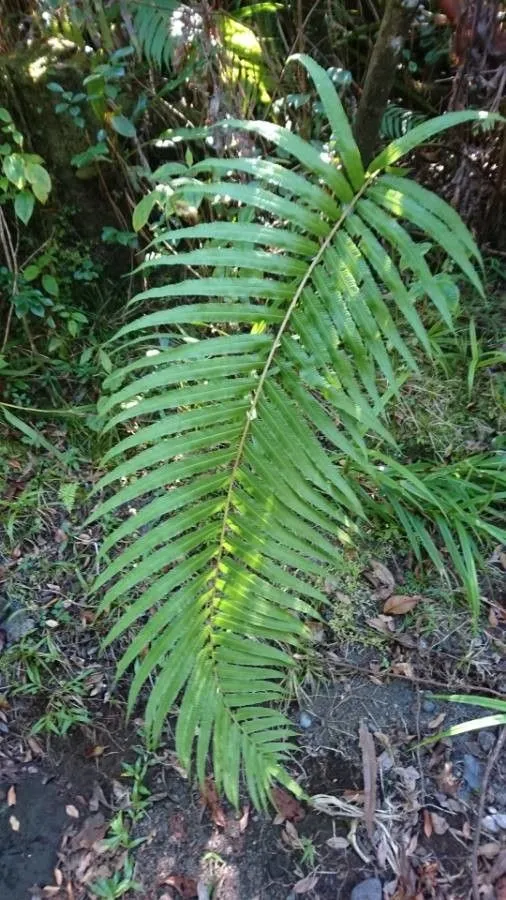
Author: L.
Bibliography: Sp. Pl.: 1074 (1753)
Year: 1753
Status: accepted
Rank: species
Genus: Pteris
Vegetable: Unknown
Observations: Trop. & Subtrop. Old World
Chinese brake, scientifically known as Pteris vittata, is a fascinating fern species that holds a significant position within the rich biodiversity of tropical and subtropical regions across the Old World. Described initially by the renowned botanist Carl Linnaeus in his seminal work “Species Plantarum” in 1753, this plant has captured the interest of botanists and ecologists alike for centuries.
Belonging to the family Pteridaceae, Chinese brake is appreciated not just for its botanical intrigue but also for its distinctive appearance and ecological contributions. The fern typically thrives in humid environments, gracing forest floors, rocky terrains, and shaded areas with its lush, arching fronds. These fronds are pinnate, often exhibiting a delicate, feather-like structure that adds a touch of elegance to the landscapes they inhabit.
Pteris vittata is more than just a plant of aesthetic value. It has garnered attention for its remarkable ability to thrive in soils contaminated with heavy metals, particularly arsenic. This unique attribute has positioned the Chinese brake as a subject of extensive research, especially in the field of phytoremediation, where plants are used to clean contaminated environments.
While its primary habitat spreads across warmer regions of Asia, Africa, and parts of Oceania, the adaptability of Chinese brake makes it a versatile species, capable of surviving in a variety of ecological niches. Its presence is significant not only in natural forests but also in disturbed areas, indicating its resilience and ecological importance.
In summary, Pteris vittata, or Chinese brake, is a noteworthy fern of the Pteridaceae family, known for its elegant fronds and its extraordinary capacity to remediate arsenic-laden soils. Its broad distribution across tropical and subtropical climates underscores its adaptability and the crucial role it plays in both natural and human-impacted environments.
Eng: chinese ladder brake, chinese brake, ladder brake
Fra: fougère à feuilles longues, ptéris urbane
Deu: gebänderter saumfarn
Spa: helecho de abichuela, filipodio cordobés, helecho de habichuela
Hun: csíkos szalagpáfrány
Ita: pteride a foglia lunghe
En: Chinese brake, Ladder brake, Chinese ladder brake, Ladder brake fern
Ar: ديشار مخطط
Bn: টেরিস ভিট্টাটা
Zh: 鱗蓋鳳尾蕨
Fi: Nauhasanikka
Fr: Fougère à feuilles longues, Ptéris urbane, Ptéris à longues feuilles, Ptéris rubané
De: Gebänderter Saumfarn, Gebänderte Saumfarn
He: אברה ארוכת עלים, אברה ארוכת-עלים
Hu: Csíkos szalagpáfrány
It: Pteridio a foglie lunghe, Pteride a foglia lunghe, Pteride à foglie lunghe
Fa: سرخس دوپایه نواری
Es: Filipodio cordobés, Helecho de habichuela, Helecho de abichuela
Zh-tw: 鱗蓋鳳尾蕨
© copyright of the Board of Trustees of the Royal Botanic Gardens, Kew.
© copyright of the Board of Trustees of the Royal Botanic Gardens, Kew.
© copyright of the Board of Trustees of the Royal Botanic Gardens, Kew.
Taken Feb 28, 2019 by Arnie Clewell (cc-by-sa)
Taken Jan 16, 2010 by Marcel B. (cc-by-sa)
Taken Oct 25, 2021 by Trap Hers (cc-by-sa)
Taken Oct 25, 2021 by Trap Hers (cc-by-sa)
Taken Sep 15, 2018 by Bernard REYNAUD (cc-by-sa)
Taken Jan 17, 2021 by FLORENCE GRESSIER (cc-by-sa)
Taken May 30, 2022 by Ramírez Ortiz Leandro (cc-by-sa)
Taken Oct 13, 2021 by Errecarte Fiorella (cc-by-sa)
Taken Apr 15, 2001 by Photoflora – Benoit BOCK (©)
Taken Dec 30, 2015 by EOL − Jesse Rorabaugh (cc-by)
Taken Apr 5, 2015 by Tela Botanica − Marie PORTAS (cc-by-sa)
Taken Dec 18, 2019 by Rajendra Rajendra Choure (cc-by-sa)
Taken Apr 28, 2017 by Philippe mary (cc-by-sa)
Taken Jun 20, 2016 by Tela Botanica − Michel PANSIOT (cc-by-sa)
Taken Jun 20, 2016 by Tela Botanica − Michel PANSIOT (cc-by-sa)
Taken Oct 15, 2006 by Photoflora – Jean-Luc TASSET (©)
Taken Apr 15, 2001 by Photoflora – Benoit BOCK (©)
Taken Jul 7, 2012 by Royal Botanic Garden Edinburgh – Anonymous (cc-by-nc)
Taken Feb 15, 2011 by Photoflora – Benoit BOCK (©)
Taken Nov 29, 2010 by Tela Botanica − Liliane Roubaudi (cc-by-sa)
Taken Aug 15, 2017 by Tela Botanica − Sylvain PIRY (cc-by-sa)
Family: Myrtaceae Author: (F.Muell.) K.D.Hill & L.A.S.Johnson Bibliography: Telopea 6: 402 (1995) Year: 1995 Status:…
Family: Rubiaceae Author: Pierre ex A.Froehner Bibliography: Notizbl. Bot. Gart. Berlin-Dahlem 1: 237 (1897) Year:…
Family: Sapindaceae Author: Koidz. Bibliography: J. Coll. Sci. Imp. Univ. Tokyo 32(1): 38 (1911) Year:…
Family: Asteraceae Author: A.Gray Bibliography: Pacif. Railr. Rep.: 107 (1857) Year: 1857 Status: accepted Rank:…
Family: Fabaceae Author: Medik. Bibliography: Vorles. Churpfälz. Phys.-Ökon. Ges. 2: 398 (1787) Year: 1787 Status:…
Family: Aspleniaceae Author: (Cav.) Alston Bibliography: Bull. Misc. Inform. Kew 1932: 309 (1932) Year: 1932…